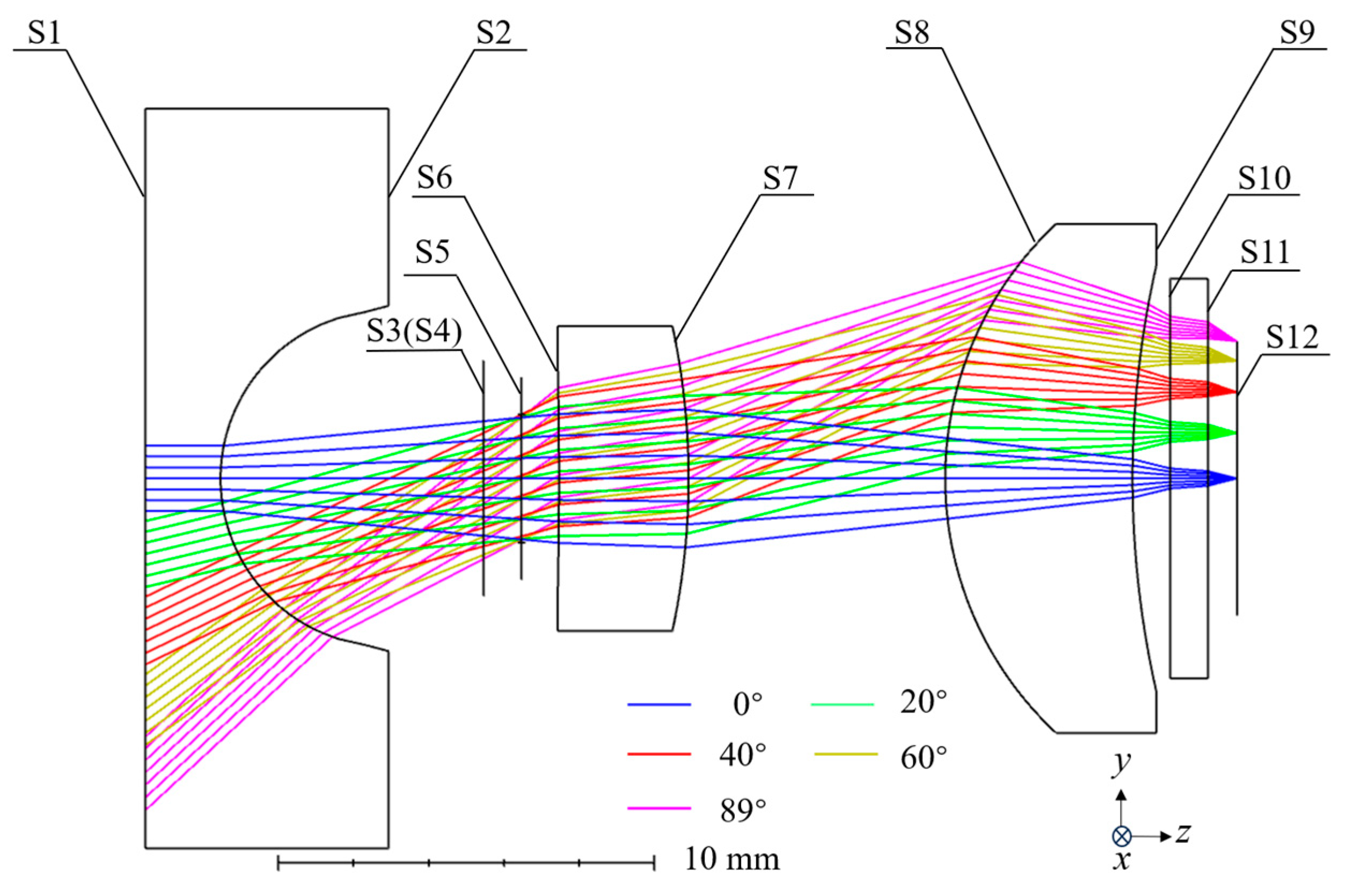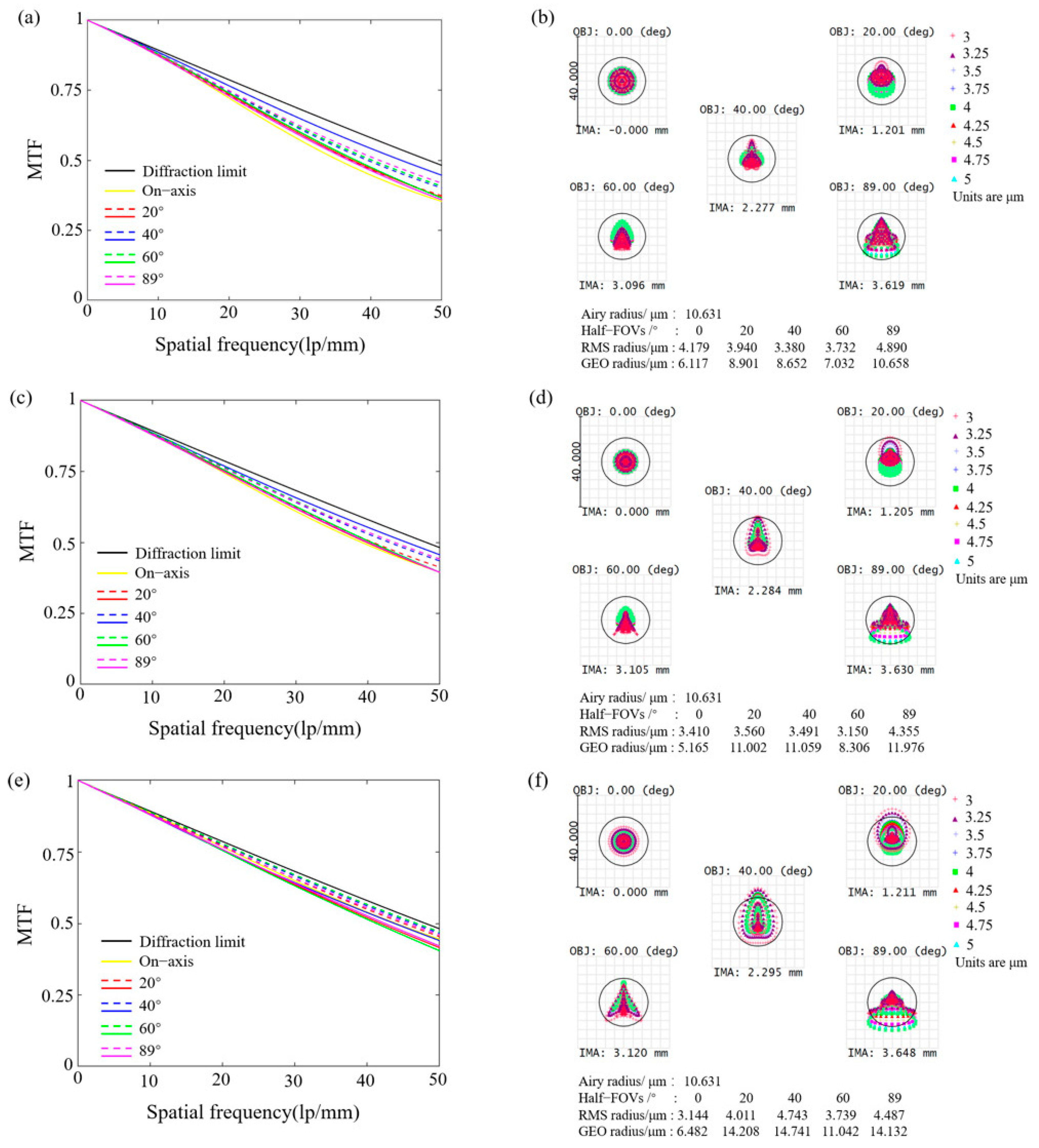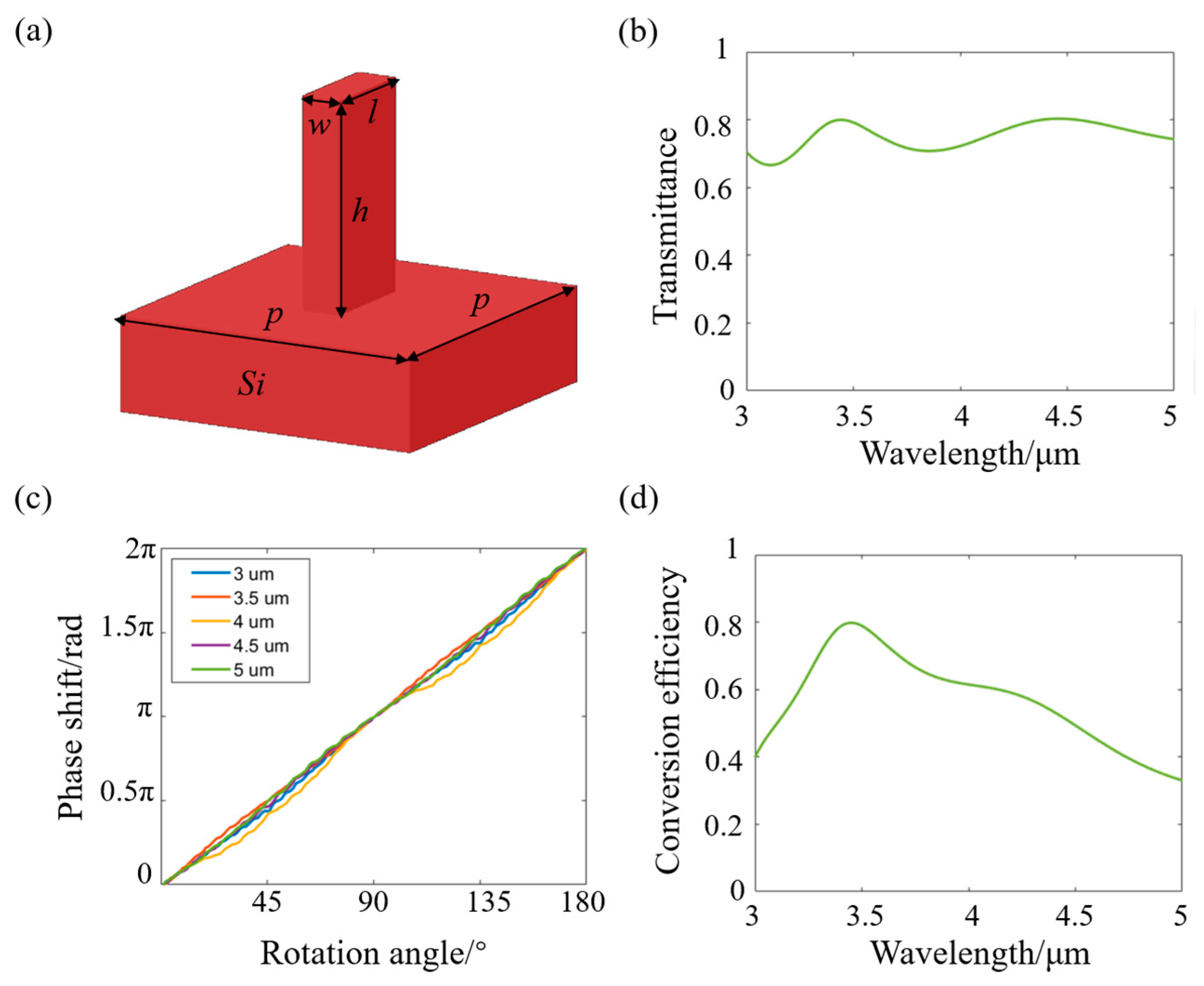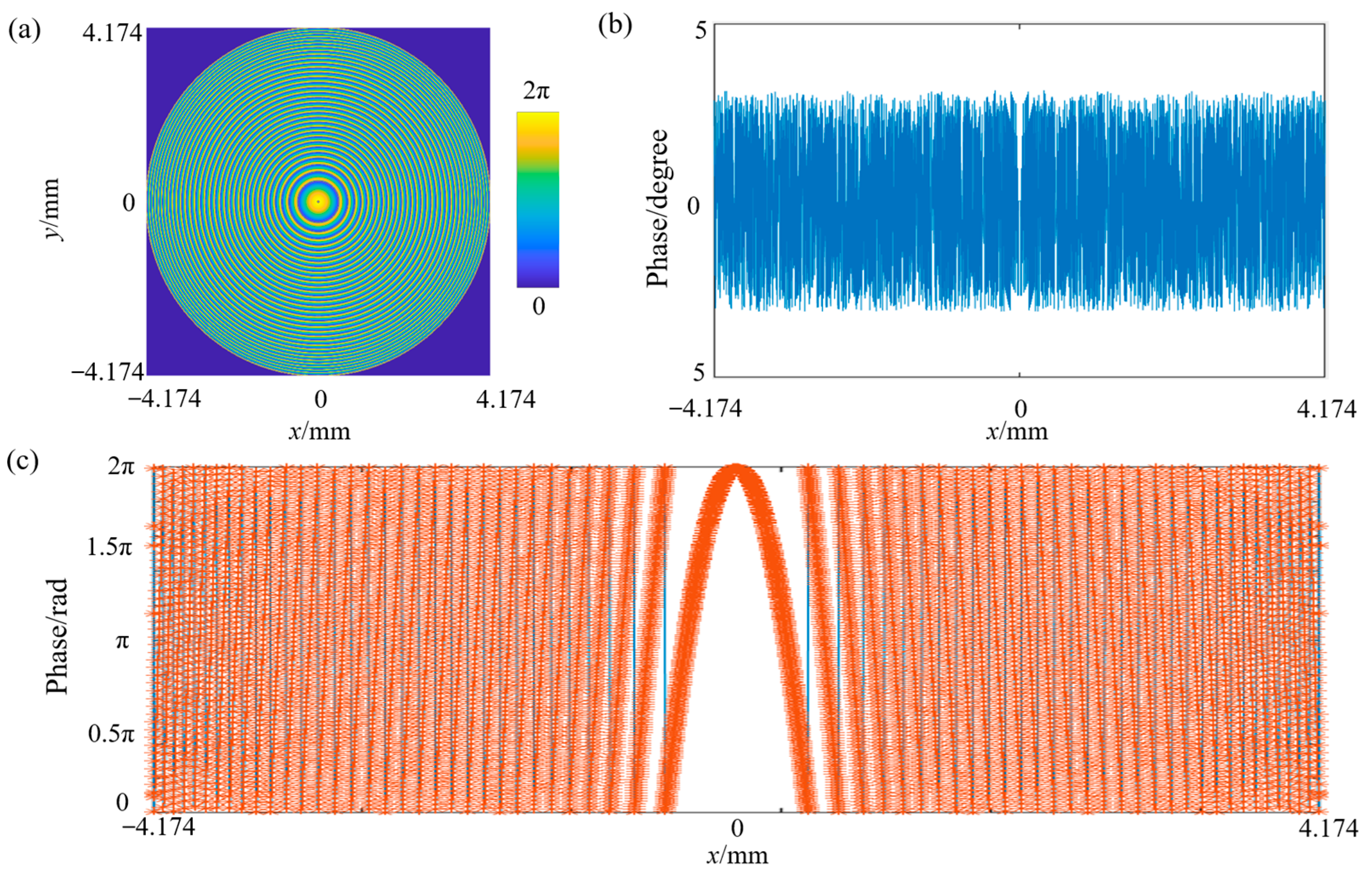Broadband and Wide Field-of-View Refractive and Meta-Optics Hybrid Imaging System for Mid-Wave Infrared
Abstract
1. Introduction
2. Discussions and Results
2.1. Design and Analysis of the Optical Imaging System
2.2. Characterization of the Circular Polarizer and the Geometric Metasurface
3. Conclusions
Author Contributions
Funding
Data Availability Statement
Conflicts of Interest
References
- Samy, A.M.; Gao, Z. Simplified compact fisheye lens challenges and design. J. Opt. 2015, 44, 409–416. [Google Scholar]
- Gledhill, D.; Tian, G.Y.; Taylor, D.; Clarke, D. Panoramic imaging—A review. Comput. Graph. 2003, 27, 435–445. [Google Scholar]
- Thibault, S. Panomorph Lens: A New Type of Panoramic Lens. In International Optical Design; Technical Digest (CD); Optica Publishing Group: Washington, DC, USA, 2006; p. WB1. [Google Scholar]
- Amako, J.; Nakano, H. Design of refractive–diffractive hybrid lenses for space–time focusing ultrashort laser pulses. Opt. Commun. 2023, 544, 129614. [Google Scholar]
- Stone, T.; George, N. Hybrid diffractive-refractive lenses and achromats. Appl. Opt. 1988, 27, 2960–2971. [Google Scholar]
- Sauer, H.; Chavel, P.; Erdei, G. Diffractive optical elements in hybrid lenses: Modeling and design by zone decomposition. Appl. Opt. 1999, 38, 6482–6486. [Google Scholar]
- Wang, P.; Mohammad, N.; Menon, R. Chromatic-aberration-corrected diffractive lenses for ultra-broadband focusing. Sci. Rep. 2016, 6, 21545. [Google Scholar]
- Yuan, W.; Li, L.-H.; Lee, W.-B.; Chan, C.-Y. Fabrication of Microlens Array and Its Application: A Review. Chin. J. Mech. Eng. 2018, 31, 16. [Google Scholar]
- Xu, M.; Xue, Y.; Li, J.; Zhang, L.; Lu, H.; Wang, Z. Large-Area and Rapid Fabrication of a Microlens Array on a Flexible Substrate for an Integral Imaging 3D Display. ACS Appl. Mater. Interfaces 2023, 15, 10219–10227. [Google Scholar]
- Chen, K.; Hou, Y.; Chen, S.; Yuan, D.; Ye, H.; Zhou, G. Design, Fabrication, and Applications of Liquid Crystal Microlenses. Adv. Opt. Mater. 2021, 9, 2100370. [Google Scholar]
- Chen, X.; Wu, T.; Gong, Z.; Li, Y.; Zhang, Y.; Li, B. Subwavelength imaging and detection using adjustable and movable droplet microlenses. Photon. Res. 2020, 8, 225–234. [Google Scholar]
- Xie, X.; Liu, K.; Pu, M.; Ma, X.; Li, X.; Guo, Y.; Zhang, F.; Luo, X. All-metallic geometric metasurfaces for broadband and high-efficiency wavefront manipulation. Nanophotonics 2020, 9, 3209–3215. [Google Scholar] [CrossRef]
- Guo, Y.; Ma, X.; Pu, M.; Li, X.; Zhao, Z.; Luo, X. High-Efficiency and Wide-Angle Beam Steering Based on Catenary Optical Fields in Ultrathin Metalens. Adv. Opt. Mater. 2018, 6, 1800592. [Google Scholar] [CrossRef]
- Chen, J.; Wang, D.P.; Si, G.Y.; Teo, S.L.; Wang, Q.; Lin, J. Planar peristrophic multiplexing metasurfaces. Opto-Electron. Adv. 2023, 6, 220141. [Google Scholar] [CrossRef]
- Li, J.; Lu, X.; Li, H.; Song, C.; Tan, Q.; He, Y.; Liu, J.; Luo, L.; Tang, T.; Liu, T.; et al. Racemic dielectric metasurfaces for arbitrary terahertz polarization rotation and wavefront manipulation. Opto-Electron. Adv. 2024, 7, 240075. [Google Scholar] [CrossRef]
- Pu, M.; Li, X.; Guo, Y.; Ma, X.; Luo, X. Nanoapertures with ordered rotations: Symmetry transformation and wide-angle flat lensing. Opt. Express 2017, 25, 31471–31477. [Google Scholar] [CrossRef]
- Engelberg, J.; Zhou, C.; Mazurski, N.; Bar-David, J.; Kristensen, A.; Levy, U. Near-IR wide-field-of-view Huygens metalens for outdoor imaging applications. Nanophotonics 2020, 9, 361–370. [Google Scholar] [CrossRef]
- Groever, B.; Chen, W.T.; Capasso, F. Meta-Lens Doublet in the Visible Region. Nano Lett. 2017, 17, 4902–4907. [Google Scholar] [CrossRef]
- Luo, X.; Zhang, F.; Pu, M.; Guo, Y.; Li, X.; Ma, X. Recent advances of wide-angle metalenses: Principle, design, and applications. Nanophotonics 2022, 11, 1–20. [Google Scholar] [CrossRef]
- Dong, L.; Kong, W.; Zhang, F.; Liu, L.; Pu, M.; Wang, C.; Li, X.; Ma, X.; Luo, X. Ultra-thin sub-diffraction metalens with a wide field-of-view for UV focusing. Opt. Lett. 2024, 49, 1189–1192. [Google Scholar] [CrossRef]
- Chen, J.; Ye, X.; Gao, S.; Chen, Y.; Zhao, Y.; Huang, C.; Qiu, K.; Zhu, S.; Li, T. Planar wide-angle-imaging camera enabled by metalens array. Optica 2022, 9, 431–437. [Google Scholar] [CrossRef]
- Yang, F.; An, S.; Shalaginov, M.Y.; Zhang, H.; Rivero-Baleine, C.; Hu, J.; Gu, T. Design of broadband and wide-field-of-view metalenses. Opt. Lett. 2021, 46, 5735–5738. [Google Scholar] [PubMed]
- Chen, Q.; Zhou, J.; Pian, S.; Xu, J.; Li, X.; Li, B.; Lu, C.; Wang, Z.; Jiang, Q.; Qin, S.; et al. Hybrid Meta-Optics Enabled Compact Augmented Reality Display with Computational Image Reinforcement. ACS Photon. 2024, 11, 3794–3803. [Google Scholar]
- Shih, K.-H.; Renshaw, C.K. Hybrid meta/refractive lens design with an inverse design using physical optics. Appl. Opt. 2024, 63, 4032–4043. [Google Scholar]
- Mao, S.; Lai, T.; Yuan, P.; Wang, J.; Zhao, J. Design of a refractive-metasurface hybrid annular aperture folded optical system. Opt. Express 2024, 32, 10948–10961. [Google Scholar]
- Liu, G.-Y.; Hsu, W.-L.; Pan, J.-W.; Wang, C.-M. Refractive and Meta-Optics Hybrid System. J. Light. Technol. 2021, 39, 6880–6885. [Google Scholar] [CrossRef]
- Yao, Y.; Wang, Z.; Zhu, Z.; He, Y.; Sun, S.; Zhou, L.; He, Q. High-Aspect-Ratio Silicon Metasurfaces: Design, Fabrication, and Characterization. Appl. Sci. 2023, 13, 9607. [Google Scholar] [CrossRef]
- Lim, S.W.D.; Meretska, M.L.; Capasso, F. A High Aspect Ratio Inverse-Designed Holey Metalens. Nano Lett. 2021, 21, 8642–8649. [Google Scholar]
- Xie, X.; Pu, M.; Jin, J.; Xu, M.; Guo, Y.; Li, X.; Gao, P.; Ma, X.; Luo, X. Generalized Pancharatnam-Berry Phase in Rotationally Symmetric Meta-Atoms. Phys. Rev. Lett. 2021, 126, 183902. [Google Scholar]






| Parameters | Values |
|---|---|
| Working waveband/µm | 3~5 |
| F/# | 2 |
| Field of view/° | 178 |
| Pixel/µm | 15 |
| Effective focal length/mm | 3.51 |
| Total length/mm | 29.00 |
| Operating temperature/°C | −40~60 |
| Surface Number | Surface Type | R/mm | T/mm | Material |
|---|---|---|---|---|
| S1 | Plane | Infinity | 2.000 | KCl |
| S2 | Sphere | 4.473 | 7.002 | —— |
| S3 | Jones Matrix | Infinity | 1.000 | —— |
| S4 | Jones Matrix | Infinity | 0 | —— |
| S5 | Stop | Infinity | 1.000 | —— |
| S6 | Sphere | −141.788 | 3.448 | Si |
| S7 | Sphere | −19.289 | 6.826 | —— |
| S8 | Sphere | 9.237 | 4.983 | KRS5 |
| S9 | Sphere | 25.705 | 1.000 | —— |
| S10 | Plane | Infinity | 1.000 | Si |
| S11 | Binary 2 | Infinity | 0.779 | —— |
| S12 | Image plane | Infinity | —— | —— |
| Name | Band/µm | FOV/° | Total Length/mm | Operating Temperature/°C |
|---|---|---|---|---|
| This work | 3~5 | 178 | 29.00 | −40~60 |
| MD4.93F2WR 2 | 3.5~5 | 120 × 90 | >50 | −40~60 |
| Xenics Tigris-640-MCT | 3.7~4.8 | - | >100 | −40~60 |
| FLIR X6981-HS InSb™ | 3~5 | - | >100 | −20~50 |
| FLIR A6700 MWIR | 3~5 | 34 × 26 | >100 | −25~55 |
| Specim FX50 | 2.7~5.3 | 60 | >100 | 5~40 |
Disclaimer/Publisher’s Note: The statements, opinions and data contained in all publications are solely those of the individual author(s) and contributor(s) and not of MDPI and/or the editor(s). MDPI and/or the editor(s) disclaim responsibility for any injury to people or property resulting from any ideas, methods, instructions or products referred to in the content. |
© 2025 by the authors. Licensee MDPI, Basel, Switzerland. This article is an open access article distributed under the terms and conditions of the Creative Commons Attribution (CC BY) license (https://creativecommons.org/licenses/by/4.0/).
Share and Cite
Liu, B.; Zhang, Y.; Li, Z.; Wei, B.; Gan, X.; Xie, X. Broadband and Wide Field-of-View Refractive and Meta-Optics Hybrid Imaging System for Mid-Wave Infrared. Nanomaterials 2025, 15, 566. https://doi.org/10.3390/nano15070566
Liu B, Zhang Y, Li Z, Wei B, Gan X, Xie X. Broadband and Wide Field-of-View Refractive and Meta-Optics Hybrid Imaging System for Mid-Wave Infrared. Nanomaterials. 2025; 15(7):566. https://doi.org/10.3390/nano15070566
Chicago/Turabian StyleLiu, Bo, Yunqiang Zhang, Zhu Li, Bingyan Wei, Xuetao Gan, and Xin Xie. 2025. "Broadband and Wide Field-of-View Refractive and Meta-Optics Hybrid Imaging System for Mid-Wave Infrared" Nanomaterials 15, no. 7: 566. https://doi.org/10.3390/nano15070566
APA StyleLiu, B., Zhang, Y., Li, Z., Wei, B., Gan, X., & Xie, X. (2025). Broadband and Wide Field-of-View Refractive and Meta-Optics Hybrid Imaging System for Mid-Wave Infrared. Nanomaterials, 15(7), 566. https://doi.org/10.3390/nano15070566








